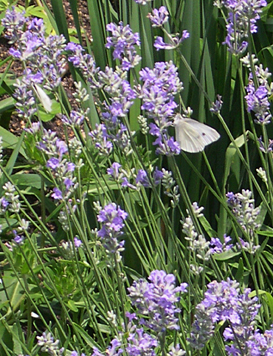 Although known as English lavender this strongly aromatic shrub is not native to England but to the western Mediterranean especially the Pyrenees and northern mountains of Spain. It is a member of the mint/deadnettle family (Lamiaceae) and grows into a mound about two to three feet high and as wide. The gray-green leaves are evergreen, one to two inches long, and narrow. The flowers are pinkish-purple and produced in terminal spikes one to three inches long held on leafless stems from late spring to early summer. It grows best in full sun and well-drained, neutral to alkaline soil, and tolerates dryness.
Although known as English lavender this strongly aromatic shrub is not native to England but to the western Mediterranean especially the Pyrenees and northern mountains of Spain. It is a member of the mint/deadnettle family (Lamiaceae) and grows into a mound about two to three feet high and as wide. The gray-green leaves are evergreen, one to two inches long, and narrow. The flowers are pinkish-purple and produced in terminal spikes one to three inches long held on leafless stems from late spring to early summer. It grows best in full sun and well-drained, neutral to alkaline soil, and tolerates dryness.
Lavender is probably most closely associated with hand made sachets and soaps but can be an important culinary herb. It has a strong taste which gets stronger over time and can contribute a lot of flavor to a variety of foods. A lavender sugar or syrup can be used to flavor baked goods such a scones, tea bread, chocolate bars, cakes, cookies, shortbread, biscotti, tarts and custard. Lavender syrup enhances fruit dishes like caramelized peaches, lavender infusions can be used to sweeten meringues and drinks like lemonade or iced tea, and lavender honey is delicious on toast. Try adding lavender to whipped cream for a cake rich tasty filling. Sweet foods are not the only ones to be enhanced by lavender and the American version of the French herbes de Provence include lavender along with savory, marjoram, rosemary, thyme, and oregano, a mixture that is good in stew as well as with grilled fish and meat.
There are several cultivars of lavender that have especially good flowers for culinary use. ‘Munstead’ is compact and grows twelve inches tall, ‘Lavender Lady’ is eighteen inches tall, and ‘Hidcote’ is fifteen to twenty inches tall. Do not use French or Spanish lavender as their taste is bitter. Both the buds and flowers of English lavender are used in recipes and can be easily harvested by encircling the stem with the hand and rubbing up and down. The flowers should be washed in water and either patted dry with a towel or dried in a spinner. They can also be dried for later use by spreading them on a paper towel and placing in a dry dark place for several days.